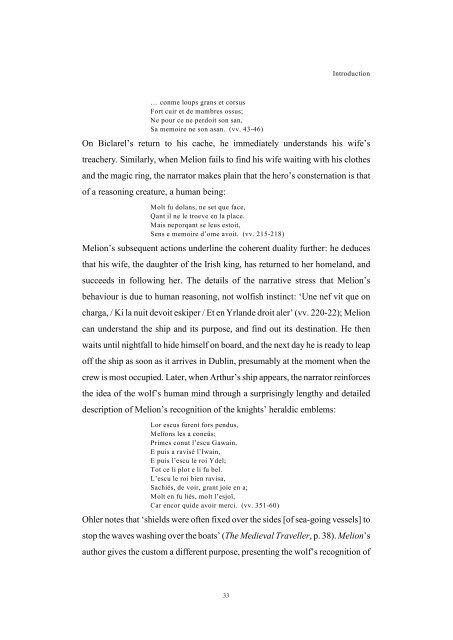Melion and Biclarel - University of Liverpool
Melion and Biclarel - University of Liverpool
Melion and Biclarel - University of Liverpool
Create successful ePaper yourself
Turn your PDF publications into a flip-book with our unique Google optimized e-Paper software.
Introduction<br />
… conme loups grans et corsus<br />
Fort cuir et de mambres ossus;<br />
Ne pour ce ne perdoit son san,<br />
Sa memoire ne son asan. (vv. 43-46)<br />
On <strong>Biclarel</strong>’s return to his cache, he immediately underst<strong>and</strong>s his wife’s<br />
treachery. Similarly, when <strong>Melion</strong> fails to find his wife waiting with his clothes<br />
<strong>and</strong> the magic ring, the narrator makes plain that the hero’s consternation is that<br />
<strong>of</strong> a reasoning creature, a human being:<br />
Molt fu dolans, ne set que face,<br />
Qant il ne le troeve en la place.<br />
Mais neporqant se leus estoit,<br />
Sens e memoire d’ome avoit. (vv. 215-218)<br />
<strong>Melion</strong>’s subsequent actions underline the coherent duality further: he deduces<br />
that his wife, the daughter <strong>of</strong> the Irish king, has returned to her homel<strong>and</strong>, <strong>and</strong><br />
succeeds in following her. The details <strong>of</strong> the narrative stress that <strong>Melion</strong>’s<br />
behaviour is due to human reasoning, not wolfish instinct: ‘Une nef vit que on<br />
charga, / Ki la nuit devoit eskiper / Et en Yrl<strong>and</strong>e droit aler’ (vv. 220-22); <strong>Melion</strong><br />
can underst<strong>and</strong> the ship <strong>and</strong> its purpose, <strong>and</strong> find out its destination. He then<br />
waits until nightfall to hide himself on board, <strong>and</strong> the next day he is ready to leap<br />
<strong>of</strong>f the ship as soon as it arrives in Dublin, presumably at the moment when the<br />
crew is most occupied. Later, when Arthur’s ship appears, the narrator reinforces<br />
the idea <strong>of</strong> the wolf’s human mind through a surprisingly lengthy <strong>and</strong> detailed<br />
description <strong>of</strong> <strong>Melion</strong>’s recognition <strong>of</strong> the knights’ heraldic emblems:<br />
Lor escus furent fors pendus,<br />
Melïons les a coneüs;<br />
Primes conut l’escu Gawain,<br />
E puis a ravisé l’Iwain,<br />
E puis l’escu le roi Ydel;<br />
Tot ce li plot e li fu bel.<br />
L’escu le roi bien ravisa,<br />
Sachiés, de voir, grant joie en a;<br />
Molt en fu liés, molt l’esjoï,<br />
Car encor quide avoir merci. (vv. 351-60)<br />
Ohler notes that ‘shields were <strong>of</strong>ten fixed over the sides [<strong>of</strong> sea-going vessels] to<br />
stop the waves washing over the boats’ (The Medieval Traveller, p. 38). <strong>Melion</strong>’s<br />
author gives the custom a different purpose, presenting the wolf’s recognition <strong>of</strong><br />
33
















